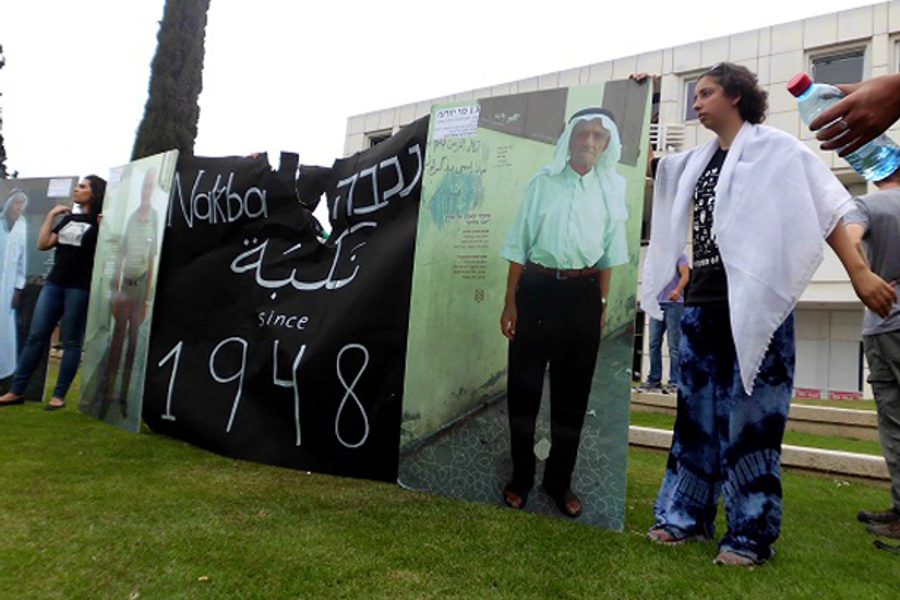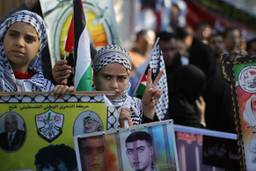
Hundreds of students assembled at Tel Aviv University (TAU) on Monday to commemorate the Nakba, or “catastrophe” in Arabic. The day marked the 65th anniversary of the state of Israel’s establishment in 1948, which coincided with the destruction of over 500 Palestinian villages and the creation of an estimated 750,000 refugees.
Nakba commemorations will be held this week throughout Israel and the occupied Palestinian territories and abroad. But the TAU commemoration was one of the only events to draw joint participation from both Jewish and Palestinian Israelis. Among the event’s organizers were students from the leftwing Israeli political party Hadash and Students against Fascism, as well as Zochrot—an Israeli organization that seeks to “raise awareness about the Palestinian Nabka, particularly among Jews in Israel.”
“As a historical event, the Palestinian Nakba is problematic for the Israeli Jewish audience,” Salah Mohsen of Adalah Legal Center tells In These Times. “Most of them are committed to the official Zionist version [of history].”
Last year, the mere announcement of the planned commemoration at TAU drew outcry from the Israeli Parliament, prompting several politicians to demand its cancellation. But conscientious activists are aiming “to start a tradition” at the university, says leftwing student organizer Dan Walfish. He believes acknowledgement of the Palestinian historical experience is indispensable to securing “a better joint future for Jews and Palestinians.”
For Israeli Jews, “understanding the Nakba is the key to understanding many aspects of the [contemporary] Palestinian struggle and the injustice that stands at the origins and essence of the Jewish state,” says Noa Levy, another student organizer at TAU. Recognition of the Palestinian narrative is central to resolution of almost all outstanding grievances, since “[today’s] land struggles all originate from the same original sin,” she notes.
Though the Nakba has been “historically recognized by Palestinians only, and in Arabic,” Levy asserts, organizers of the commemoration at TAU sought to “find ways to speak this subject to the Israeli population.”
Alternating between Hebrew and Arabic, activists used megaphones to read off the names of villages destroyed during the 1948 violence. When Palestinian students shared their family’s experiences, the focus was not on specific, contentious political issues. Instead, they told stories that humanized the collective pain of dispossession.
TAU graduate Asrar Kayyal’s family came from El-Birweh, which was populated by both Palestinian Christians and Muslims. Following the occupation of El-Birweh by Israeli forces in June 1948, many of Kayyal’s relatives were displaced internally after their homes were destroyed. “The rest of them live in Lebanon today,” she told the several hundred students in the audience. “We commemorate the Nakba every year and visit the village’s remains together.”
“After El-Birweh’s refugees eventually became Israeli citizens, the people were not allowed to return — even though most of the land is empty. I feel paralyzed on the drive to work each morning when I see where our homes were replaced by cowsheds.”
Rula Khalaily, a member of the Democratic Front for Peace and Equality, recited Palestinian national poet Mahmoud Darwish’s “On Steadfastness.” Another five female students told the audience how their parents’ and grandparents’ generations experienced the pangs of eviction and dispossession, what one student referred to as becoming “a stranger in your own home.”
Speaking about the Nakba in a public setting presents a number of difficulties. The Nakba Law, passed in 2011, authorizes the Israeli government to defund or impose heavy fines on any state-funded or tax-exempt organization commemorating Israel’s establishment “as a day of mourning.” Though TAU falls under this umbrella, the commemoration wasn’t officially affiliated with any student organizations, and thus “there’s no law that we’re breaking,” says Walfish.
The commemoration’s venue, a prominent Israeli university, represents an effort to mobilize an often overlooked demographic of Israeli society: Palestinian citizens of Israel.
According to Adalah’s database, the Arab minority in Israel (around 1.5 million people) faces at least 57 discriminatory laws, more than 30 of which were passed since the 2009 election of ultra-rightwing Prime Minister Benyamin Netanyahu. Such legislation translates to limited political freedoms and access to land for non-Jewish Israeli citizens.
Unsurprisingly, Palestinian student activists also face greater risks than their Jewish classmates for participation in political activities.
Among the 60 instances of anti-Arab discrimination documented in the Arab Culture Association’s “Annual Summary Report” were the decisions of Haifa University and Hebrew University to prevent Nakba commemorations from taking place in 2012, as well as restrictions placed on the TAU commemoration. Students had to pay for their own security, and were unable to gain administrative approval for a number of guests who had been invited to speak.
“When Arab students in Israel are not allowed to express their opinion or recognize their own history, [this is a clear case of] discrimination that Jewish students don’t face,” says Adalah’s Mohsen.
Unlike last year, no clashes transpired during yesterday’s Nakba commemoration at TAU. But the peaceful assembly was not without its detractors: An adjacent counter-protest drew participation from several rightwing activists from Im Tirtzu, an “extra-parliamentary” political organization that “works to strengthen and advance the values of Zionism in Israel.”
Counter-demonstrators regard the Nakba commemoration as a denial of Israel’s right to exist, often dishing out allegations of anti-Semitism. “We won’t mourn your failure to massacre the Jewish people in 1948,” one sign read.
Im Tirtzu’s Ben Gross told In These Times that the movement had no problem with Palestinian students regularly protesting. His words, however, seemed to contradict a number of the movement’s actions, such as handing out pamphlets that read “Nakba bullshit” in Hebrew, which was translated to English as a sanitized “Nakba nonsense.”
Despite this reaction, the commemoration’s organizers said they will continue to mark the Nakba annually. These efforts are part of a growing movement to challenge the state’s official historical line, which include activities such as alternative tours of Palestinian-majority regions and Hebrew-language travel guides that detail demolished Palestinian villages.
“We want to show that the Nakba is not an external or distant pain but the story of this land,” Walfish concluded, “and it’s shared by both Palestinians and Jews.”



